On May 21 2015, the Russian Information Network website reported that the statue of Lenin in the Ukrainian town of Gulyai-Pole had been torn down by an unidentified group. This was in itself not especially significant news: the destruction of Marxist monuments had at this point become commonplace throughout Ukraine, first as part of the Euromaidan revolt and then codified into law by Petro Poroshenko’s decommunisation campaign. This systematic process of removing emblems of the criminal Soviet regime has seen tens of thousands of streets and squares renamed and thousands of statues removed in recent years, including over 1000 of Lenin alone, in what had become known as the Leninopad.

Not the statue in Gulyai-Pole, but a similar incident.
What makes the removal of the statue in Gulyai-Pole significant lies in the history of the town itself. In 1888 it was the birthplace of Nestor Makhno, who would later use Gulyai-Pole as the base of operations of the Revolutionary Insurrectionary Army of Ukraine, the Makhnovists. The RIAU was formed in the context of the destruction of the Russian Empire. In the ensuing chaos of the Russian Civil War, dozens of armies wrestled for control over the former territories of the Empire. In Ukraine, these forces included troops of the Austro-Hungarian and German Empires, local warlords, nationalists and the Red Army. The Makhnovists committed themselves to carving out the Free Territory, an area controlled not by any state, but by self-governing communes guided entirely by anarchist principles. Combatting foreign and local oppressors alike, the Makhnovists are today recognised as one of the few historical movements that came within range of the anarchist horizon. Their defeat at the hands of the treacherous Red Army is likewise recognised as a key moment in exposing the totalitarian nature of Marxist-Leninism.
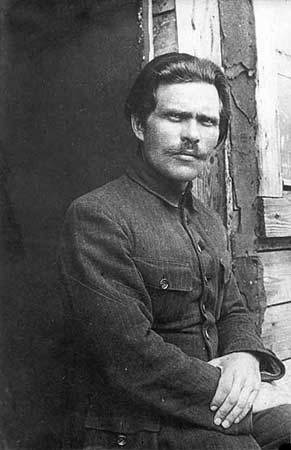
Nestor Makhno
Anarchists are not alone in celebrating Makhno’s legacy, however. In the aftermath of the Soviet collapse both the Ukrainian state and local fascists have capitalised on the Makhnovist’s resistance to foreign intervention, including that of the primarily Russian Red Army’s, to promote an aggressive form of ultra-nationalism. This has seen Makhno placed alongside the WWII fascist war-criminal Stepan Bandera as a nationalist icon. Deliberately ignoring the Makhnovist’s anarchist principles, both the state and the fascists have sought to turn Makhno into an anti-Russian thug on par with a Nazi collaborator. It is very true that the Makhnovists fought Russian forces, both White and Red, during the Civil War, but they also combatted Ukrainian, German and Austro-Hungarian forces. It is obvious in the White’s case that the Makhnovists should have combatted efforts to return to Tsarism. The Makhnovists entered into alliance with the Bolsheviks on several occasions, however, with Makhno even meeting Lenin in Moscow. Though the Makhnovists were prepared to honour their alliances with the Red Army, it was the Bolsheviks who cowardly betrayed these alliances and eventually destroyed the Makhnovists as a movement. This scarcely rings of xenophobic behaviour on the Makhnovist side. As one Makhnovist declaration made clear:
“Each revolutionary insurgent must remember that the enemies of himself, as well as of the entire people, are the rich bourgeoisie, Russian, Ukrainian, or Jewish; their enemies are all those who defend the unjust regime of the bourgeoisie” [2].
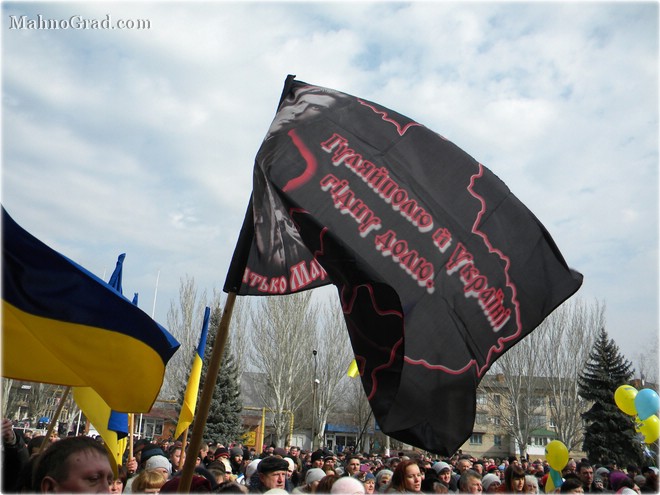
March 2014- the image of Makhno is employed alongside nationalist emblems during a protest against Russian aggression in Gulyai-Pole.
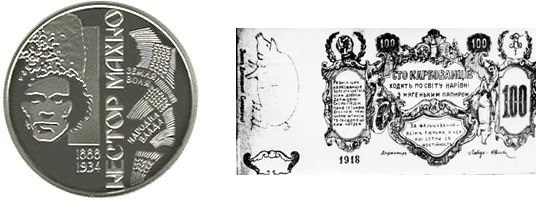
An illustration of the incompatibility of the Makhnovists and the state. On the left, a commemorative coin devoted to Makhno commissioned by the Ukrainian state in 2013. On the right, fake money distributed by the Makhnovists themselves, reading “A Hundred Karbovantsi are Accepted around the World on a Par with Soft Paper (evidently, reference to toilet paper). Free Currency Exchange of These Karbovantsi Is Guaranteed by All of the State Property of Skoro-Padiya (Soon Will Fall State; the then hetman of Ukraine was named Skoropadsky), by the Lies of Mr Hetman, by the German Bayonets and by the Haydamaky (Bandits) Lashes. Emblem of the State Treasure (inscription under the pig)” [3].
The Makhnovist’s current employment as anti-Russian standard-bearers in Ukraine can be identified in the context of not just the drive to consolidate Ukraine’s independence from Russia, but in Russia’s annexation of Crimea and support for the separatist movement in Donbass. Historical examples of individuals and organisations that have fought Russian influence have been drawn upon from both the left and right, regardless of their goals in those struggles, and thrown together in a bizarre mish-mash of groups that would have fought one another tooth and nail had they encountered one another. Thus we see neo-Nazi Right Sector’s surreal summarisation of Ukrainian history:
“…the Ukrainian ancestry didn’t interrupt despite the barrage of wars and repressions, manifesting itself through generations and generations in worthy souls …With the first shots of World War I, in 1914, these dignitaries created the divisions of Sichovi Striltsi, died near the village of Kruty, and dashed in the Makhno wagons with devil’s breathing through the steppes fighting the whites and the reds, and the other Antanta invaders. But there was not enough power. The flame of liberty was extinguished under the Bolshevik heel. But they didn’t lower their heads and created UVO-OUN. It is exactly about them – “Executed Renaissance” in the Soviet Ukraine. They were winning in the World II under “Hurrah!” as well as under the slogan “Glory to Ukraine!” They have created the Ukrainian Insurgent Army (UPA) – the army of undefeated, the army without a state, the only one that did not surrender even after the war” [4].
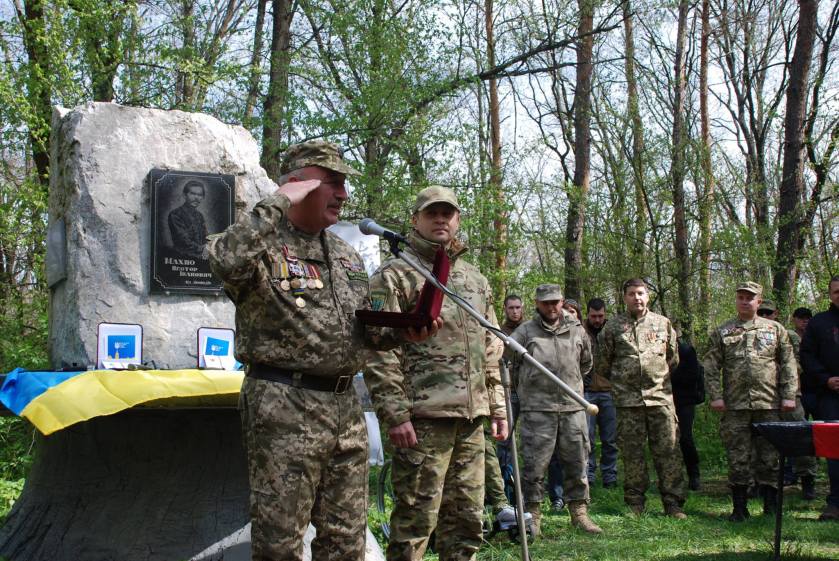
Nationalist militants of the Ukrainian Volunteer Army hold award ceremony in front of Makhno memorial, 2016. The table to the right is draped with the flag of the Banderist UPA.
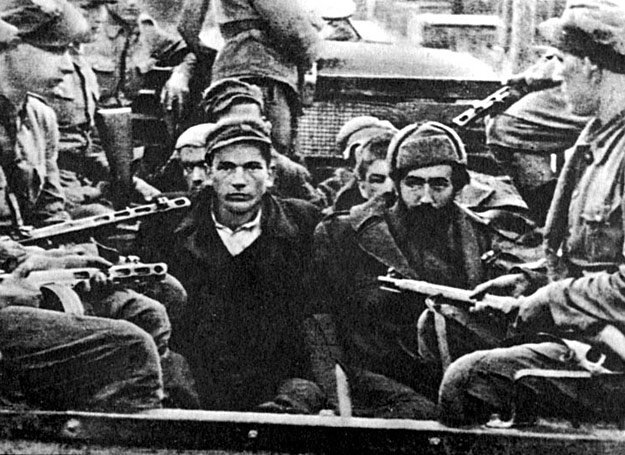
UPA militants round up Polish Jews during WWII.
It can seen here that Right Sector is attempting to establish a direct lineage from the RIAU through to the UVO(the Organisation of Ukrainian Nationalists) and the UPA, despite the fact that both of the latter organisations were strongly influenced by Nazism and anti-Semitism and were guided, of course, by a toxic mix of nationalism and xenophobia. While the anti-Jewish pogroms carried out by the UVO are common knowledge, the Makhnovists took a firm stance against anti-Semitism, arming Jewish groups, shooting the ringleaders of pogroms when they were discovered and on one occasion executing an RIAU member who had put up anti-Semitic posters [5]. In contrast to the modern day self-proclaimed heirs to Bandera’s legacy who proclaim ‘glory to Ukraine’, the Russian anarchist Peter Arshinov, a combatant of the RIAU, noted that “Denikin’s troops, the Austro-Germans, Petliura, the French troops in Berdyansk, Wrangel — were all treated by the Makhnovists as enemies of the workers. Each one of these invasions represented for them essentially a threat to the workers, and the Makhnovists had no interest in the national flag under which they marched” [6].
So what did the Makhnovists march for? Makhno describes the goal: “Anarchism’s outward form is a free, non-governed society, which offers freedom, equality and solidarity for its members. Its foundations are to be found in man’s sense of mutual responsibility, which has remained unchanged in all places and times. This sense of responsibility is capable of securing freedom and social justice for all men by its own unaided efforts. It is also the foundation of true communism” [7]. There is little in this to indicate any sympathy for nationalist sentiment.
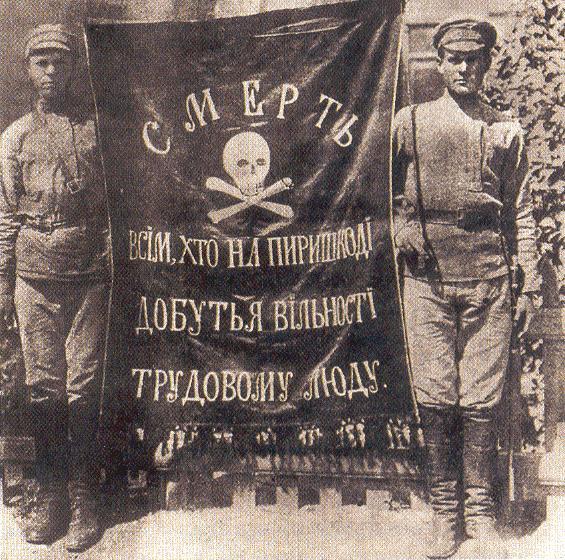
The RIAU’s banner: “Death to all who stand in the way of freedom for working people”.
Makhno had little sympathy for nationalists at all, in fact. He recalls how in August 1920,
two detachments of Petliurist nationalist leanings, under the command of Levchenko and Matyansha, encircled by us, sent emissaries to us to suggest that they be incorporated into our ranks. The Staff and I received them and agreed that they could be enlisted: however, as soon as we realized that the nationalistic elements from these detachments were engaging in looting and blatant anti-Semitism, we shot them out of hand, in the village of Avereski, in Poltava province [8].
With regards to state-based attempts to co-opt Makhno, Makhno’s rebuttal is resounding: the “fact that the modern State is the organizational form of an authority founded upon arbitrariness and violence in the social life of toilers is independent of whether it may be “bourgeois” or “proletarian.” It relies upon oppressive centralism, arising out of the direct violence of a minority deployed against the majority. In order to enforce and impose the legality of its system, the State resorts not only to the gun and money, but also to potent weapons of psychological pressure. With the aide of such weapons, a tiny group of politicians enforces psychological repression of an entire society, and, in particular, of the toiling masses, conditioning them in such a way as to divert their attention from the slavery instituted by the State” [9].
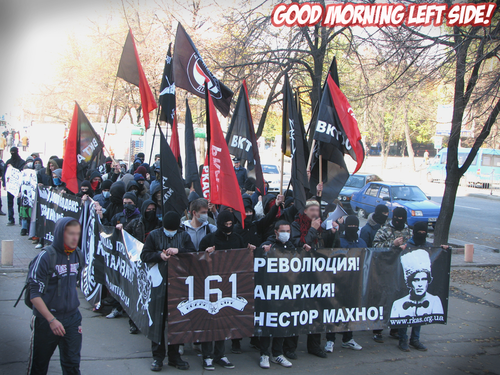
Remembering Makhno the right way: modern Ukrainian anarchist banner: “Revolution! Anarchy! Nestor Makhno!”
It should be clear from these quotes that Makhno and his followers in the RIAU held values absolutely opposed to his would-be rehabilitators in the Ukrainian state and nationalist movement. Though they combatted invaders encroaching on the territory of Ukraine, they did not do it out of a love of nation and flag, but for freedom from oppression at the hands of the very kind that today seek to use him to further their statist agendas. Though archists/statists from the left and right may fantasise that Makhno would somehow approve of their projects, it is far more likely that he would have had them placed against a wall and shot. While anarchists should rejoice at the smashing of the symbols of Marxist-Leninist tyranny, we must remain wary of the motivations and reject attempts to coopt our movement’s history for statist aims. It’s not unusual for the right to coopt anarchist symbolism and rhetoric. After all, as the Czech Anti-Fascist Action notes:
- Neo-Nazis suffer from the lack of creative people inside their own movement.
- Neo-Nazis need to put their radical views in a nice and acceptable package.
- For neo-Nazis, it is not the views, political agenda or coherent ideals that are important. They care more about gaining political influence, power and action of any kind – even senseless.
- Neo-Nazis want to confuse the public and make it hard to tell who is on which side of the barricade.
- Neo-Nazis have gotten into a situation where any change is better than none [10].
In the face of right-wing attempts to coopt Makhno, we should point out that the Makhnovist’s project remains the project of all anarchists today, if you excuse the gendered language that was common at the time (we can take Makhno’s referral to men, man and brotherhood as universal to all people):
Anarchistic Communism is a great community in total harmony. It is formed voluntarily by free individuals who form associations and federations according to their needs. Anarchist Communism fights to secure man’s freedom and his right to boundless development; it fights against all the evils and injustices that are inherent in governments.
The free, non-governed society aims to embellish life with its intellectual and manual work. It will have as its resources all that nature gave man as well as nature’s own inexhaustible riches; it makes man drunk with the beauty of the earth and exhilarated by his own, self-made freedom. Anarchist Communism will let man develop his creative independence in all directions; its adherents will be free and happy with life, guided by brotherly work and reciprocity. They will need no prisons, hangmen, spies, or agents, which are products of the bourgeoisie and socialists, for they will have no need of the idiot robber and murderer that is the State [10].
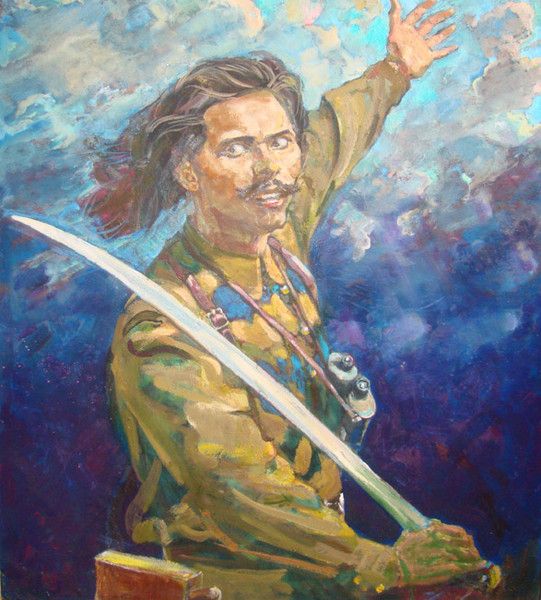
- http://news.rin.ru/eng/news/110523/
- https://libcom.org/history/anti-semitism-makhnovists-michael-malet
- http://www.wumag.kiev.ua/index2.php?param=pgs20083/130
- https://sectorpravdy.com/en/essays/1304-we-the-followers-of-bandera-we-are-coming
- https://libcom.org/history/anti-semitism-makhnovists-michael-malet
- http://www.nestormakhno.info/english/makfaq/h_6_11.htm
- http://theanarchistlibrary.org/library/nestor-makhno-the-anarchist-revolution
- http://theanarchistlibrary.org/library/nestor-makhno-the-struggle-against-the-state-and-other-essays#toc1
- ibid.
- http://www.antifa.cz/content/big-neo-nazi-crib
- http://theanarchistlibrary.org/library/nestor-makhno-the-anarchist-revolution
